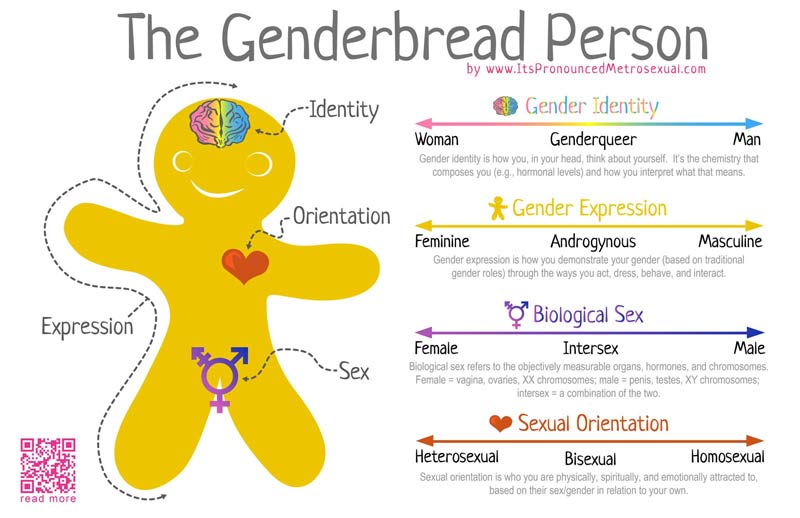Gender, Sex, and Intersex
Sex and Gender
Medical Definition of Sex and Gender
- Sex
- Merriam‐Webster's medical definition of sex is “either of the two major forms of individuals… male or female”, which are determined by “the sum of the structural, functional, and behavioral characteristics… involved in reproduction.”
- Gender
- Similar to the medical definition of sex, the medical definition of gender is also “either of the two major forms of individuals,” as well as “the behavioral, cultural, or psychological traits typically associated with one sex.”
In the eyes of medical professionals, sex and gender are supposedly one and the same, completely interconnected. Yet, according to feminist definitions, this is not so.
Feminist Definition of Sex and Gender

Created By It's Pronounced Metrosexual
- Feminist Definition of Sex
- Sex is based on one’s genitalia, hormones, and chromosomes alone.
- Feminist Definition of Gender
- Gender is a socially constructed term representative of society’s expectations for each sex. Females are associated with femininity,fragility, and submissiveness, as well as are associated with items such as dresses and dolls. Males are associated with dominating masculine qualities such as assertiveness, agressiveness, and strength.
To feminists, gender signifies personal expression—they view masculinity as a trait that not only men can possess, and view femininity as a trait both males and females can possess. Feminists believe that sex and gender are two strikingly different and separate things, and thus beleive in the acceptance of those who fall outside of the gender binary.
Thus, tensions between medical and feminist understandings of gender and sex have brought those who are born outside of the gender binary (meaning males and females) into the spotlight: intersex individuals.
Intersex: What Is It?
Now that we have defined both Sex and Gender, it is time to explain the meaning of intersex.

- Intersex
- Intersexuality, medically known as either Disorders or Differences of Sex Development (DSD for short, although most prefer to use the cultural term “intersex”), is a condition in which a person is born with genitals and sexual reproductive organs that are atypical of average males or females. This means that an intersex individual is born with a mixture of male and female genitals.
This condition sounds quite similar to that of a hermaphrodite, or a person born with the fully‐developed sexual organs of both genders. However, intersexuals and hermaphrodites are quite different, as intersexuals are born with underdeveloped parts of both sexes internally, externally, or have a combination of the two. This includes cases in which a female is born with testes or a male is born with one or more ovaries. Intersexuals may also develop secondary characteristics that are atypical for their sex, such as beards on females and breasts on males. These individuals may even vary at the chromosomal level.
This condition is quite rare within the human population. Between 1.7% and 4% of the world’s population is born with some variation of DSD. However, while this condition challenges the gender binary, in most cases surgery is not required in order for intersex people to live a normal, healthy life.
There are a number of medical conditions that are known to cause a child to be born intersex,and some of the most common conditions include 5‐alpha reductase deficiency, congenital adrenal hyperplasia (CAH), and androgen insensitivity syndrome (AIS). To read more about 5‐alpha reductase deficiency, please view the “Treatment of Intersex Individuals Across The Globe” page. To learn more about the numerous other conditions that are known to cause intersexuality in developing babies, please view the “Intersex Conditions” page compiled by the Intersex Society of North America. This provides an in‐depth list of intersex‐causing medical conditions, and provides more information on how to tell whether or not an individual is intersex.
History of Corrective Surgery on Intersex Individuals
While this condition affects very few people, it has become a large issue to the the medical community due to it creating a third gender. Since discovering the existence of intersexuals, medical professionals have been trying to “normalize” them by transitioning them into typical‐looking males and females through corrective genital surgery. In the United States, it is estimated that every day, five children are subjected to corrective genital surgery that may leave them scarred both emotionally and physically. This surgery is purely a cosmetic fix; it is a medically unnecessary procedure with many negative physical and emotional side effects.
Corrective genital surgery began in the 1950s, when a sexologist and psychologist named John Money theorized that intersex individuals were psychologically neutral at birth. He essentially stated that an infant's psychological development was malleable. Money argued that, because of this malleability, intersex individuals would develop based on the appearance of their genitalia. Thus, he advocated for infants to undergo corrective surgery in order to be normalized to either the male or female sex, believing the children who underwent the surgery would never know the difference.
Money's surgical proposal includes the alteration of the ambiguous genitalia based on a case-by-case basis, as the severity of each intersex individual's medical condition can vary greatly. After performing the surgery, doctors would then persuade the parents to raise the child as the newly assigned gender, even going so far as to encourage parents to keep the truth of their child's identity secret, even from the child. This procedure was popular throughout the 1960s, and became the standard method of handling intersex cases by the 1970s.
Even today, this surgery is still a widely-accepted procedure within the United States; it is highly advised for a child with a penis of less than 2.5 centimeters in length to be altered from male to female, and for females born with a clitoris larger than one centimeter to undergo surgery to remove the excess skin.